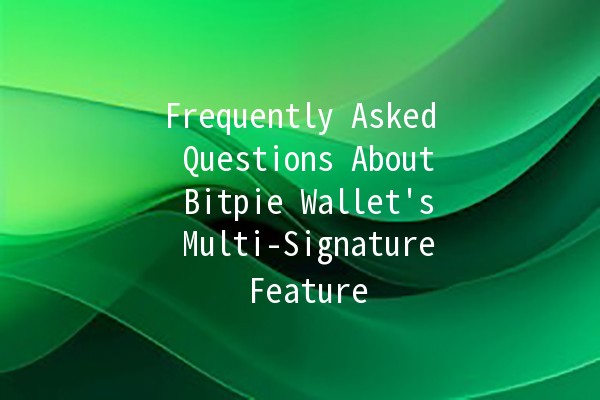
to MultiSignature Wallets
In the world of cryptocurrency, security is paramount. Multisignature (or multisig) wallets offer an advanced level of protection against unauthorized access and potential loss of funds. Bitpie Wallet, a prominent player in the crypto wallet space, incorporates this feature to provide users with enhanced security measures. This article will delve into various aspects of Bitpie Wallet's multisignature feature, addressing common user queries and offering insights into maximizing productivity while managing this advanced security option.
Understanding MultiSignature Functionality

What Is MultiSignature?
Multisignature technology requires multiple private keys to authorize a transaction. Unlike traditional wallets, where one key is sufficient, multisig wallets demand a consensus from several keys before executing any action. This approach mitigates risks from single points of failure and unauthorized access.
How Does Bitpie's MultiSignature Work?
Bitpie Wallet allows users to set up multisignature wallets in varying degrees of security. Users can create wallets that require multiple signatures from different devices or users. The wallet can be configured based on user needs, such as requiring 2 out of 3 signatures for a transaction.
Productivity Enhancement Techniques
Managing cryptocurrencies securely can be a daunting task, but there are several techniques you can employ to maximize productivity when utilizing Bitpie Wallet’s multisignature feature.
Explanation: When setting up a multisignature wallet, define who holds which key and their specific role in the transaction process.
Example: If a wallet is shared among a team, assign one member as the primary approver, another as a secondary approver, and the third as a backup. This structure clarifies responsibilities and expedites decisionmaking during transactions.
Explanation: Create a shared document (such as a Google Doc) to track transactions that require multiple approvals.
Example: Whenever a transaction is initiated, record the date, amount, and involved parties in the document. This practice fosters transparency and accountability among all parties involved.
Explanation: Implement notification systems to alert all signers when a transaction is initiated, requiring their approval.
Example: Use a group messaging app to notify signers immediately when action is needed. Quick responses ensure that transactions are not delayed due to oversight or unavailability.
Explanation: Ensure that all private keys associated with the multisignature wallet are securely backed up.
Example: Store backups in secure locations, such as a safe deposit box or an encrypted USB drive. This action reduces the risk of losing access to the wallet due to lost or damaged devices.
Explanation: Periodically audit the wallet’s security measures and access logs to ensure compliance and safety.
Example: Schedule monthly reviews of transaction histories, access patterns, and security settings. This practice helps identify any unusual activity and enhances overall security posture.
Common User Questions
Question 1: What happens if one signer loses their key?
When one signer loses their key, the wallet may still function depending on the configuration. For example, in a 2of3 multisignature arrangement, the other two signers can continue processing transactions. It is crucial to have a backup plan and access recovery options to avoid being locked out of the wallet.
Question 2: Can I use a multisignature wallet for daily transactions?
Yes, multisignature wallets can be utilized for daily transactions. However, users should balance security with convenience. For frequent transactions, consider keeping a smaller amount in a nonmultisignature wallet while using multisignature wallets for larger holdings.
Question 3: Is it safe to store all my funds in a multisignature wallet?
While multisignature wallets provide enhanced security, it is also vital to diversify your assets. Even with highsecurity measures, having all funds in one location presents risks. Consider splitting your assets across different wallet types to mitigate risk.
Question 4: How do I set up a multisignature wallet in Bitpie?
To set up a multisignature wallet in Bitpie, navigate to the wallet creation section, select the multisignature option, and follow the prompts to designate participants and configure the required signatures. Ensure all participants understand their roles before initiating the process.
Question 5: What are the fees associated with multisignature transactions?
Fees for multisignature transactions in Bitpie are similar to those of regular transactions. However, consider that multisignature transactions may require additional processing time, potentially leading to fluctuating fees based on network conditions.
Question 6: Can I convert a regular wallet to a multisignature wallet?
While some wallets allow conversion, Bitpie typically requires the creation of a new multisignature wallet. Users should backup their original wallet and follow the setup steps to create a multisig version.
Additional Considerations for Using Bitpie Wallet
While the multisignature feature significantly enhances the security of your digital assets, here are some additional aspects to bear in mind:
Security Best Practices
Always Update Software: Regularly update your Bitpie Wallet to safeguard against vulnerabilities.
Phishing Awareness: Stay vigilant about phishing attempts, especially since multisignature transactions may attract malicious actors.
Educate All Participants: Ensure that all users involved with the multisignature wallet are educated about security practices and the operational aspects of the wallet.
Transaction Planning
Plan Large Transactions: For important, large transactions requiring multisignature approval, allocate sufficient time for all parties to review and approve.
Use Test Transactions: Whenever familiarizing yourself with new procedures or settings, perform minor test transactions first to avoid costly mistakes.
By implementing these techniques and staying informed about the functionalities and safety measures associated with the multisignature feature of Bitpie Wallet, users can enhance their cryptocurrency management and security. Remember that diligence and communication within your team are key factors in successfully utilizing this advanced wallet capability.

